
Festivals in Bhutan
The most popular attractions for visitors and citizens alike in Bhutan is the annual festival called the tshechu. The festival defines Bhutan in its traditional, cultural and religious grandeur and with overtime has become very popular.
The tshechu (festival) is a religious event held in the tenth day of the Bhutanese lunar calendar. It is held on different months in different places. The festival unravels the essence and beliefs of tantric Buddhism in magnanimity and it is believed to ward off evil through masked dances choreographed hundreds of years ago with music and rituals. The originality of the dance moves has been retained for centuries and it is considered a sin to alter any of its form.
The tsechus are a delight for tourists to take photographs. The festival itself is a tiny Bhutan that encapsulates almost everything about Bhutan, to people, religion, tradition, culture, arts and architecture and mythology. It is believed that the mask dances blesses onlookers, cleanses all sins, and teaches the dharma. The dancers emulate deities, gods, demons, animals, in compassionate and wrathful forms to impart the teachings. The festival lasts for three to five days. On the last day, a large scroll painting, usually centuries old, is unveiled and it is believed that the sight of the painting will liberate onlookers. The tshechu is an honor to the life and teachings of the Indian saint, Padmasambhava, popularly known as Guru Rinpoche, who came to Bhutan in 746 AD and introduced the Nyingma school of Buddhism in Bhutan. Public holidays are declared during the tshechu and people of all ages dress up in their best attires and come to witness the festival. Outside the dzongs (fortresses) where the festivals are held, several makeshift shops provide tourists a good bargain to buy souvenirs.
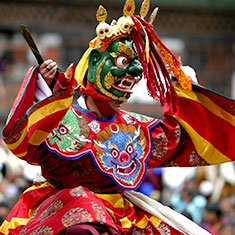
Punakha Tshechu (festival) | 15th - 17th Feb 2019
The festival commemorates the success of the man Ngawang Namgyel who unified Bhutan for the first time in history. A lama who came to Bhutan from Tibet in 1616 AD and became a powerful ruler. Between 1616 and 1651, the Tibetan forces attacked Bhutan to recover some important Buddhist relics which the Zhabdrung brought with him. He invoked the help of guardian deities and defeated the Tibetans every time.
Thus, the festival commemorates the victory over the Tibetan forces and also worships the local guardian deities who helped the Zhabdrung. The deities are still considered to be the national deities protecting the country, they are invoked in times of national threats and emergencies.
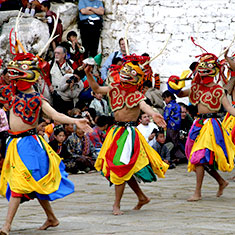
Paro Tsechu (festival) | 17th - 21st March 2019
The Paro Dzong, where the festival is held, is one of the most beautiful fortresses in the country. With the only airport of Bhutan located in Paro, the festival is one of the most popular with tourists. It is believed that Bhutanese should visit this festival at least once in their lifetime. Therefore the festival attracts thousands of people around the country.
The main highlights of this festival is the unveiling of Thongdrel (gaint applique scroll painting) early in the morning in the last day of the festival. It is said that onlookers are cleansed from their sins by seeing it. History has it that despite several fires, the thongdrol escaped miraculously, every time. Just about 200 meters away from the dzong is located the oldest museum in the country.
The festival is dedicated to the main protecting deity of Bhutan, Yeshey Goenpo, an emanation of Avalokiteshvara, the God of Compassion. The Dalai Lama is also believed to be one of the reincarnations of Avalokiteshvara. Yeshey Goenpo, also known as Mahakala, is a wrathful deity that brings the mind into attentive focus.
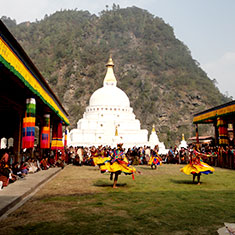
Chorten Kora (festival) | 21st March - 5th April 2019
The festival draws people from all over the country and also from the neighboring Indian state of Arunachal Pradesh who walk for days to attend the festival. It is held at a stupa near a river. The stupa is one of the few in the country that resembles the Boudanath Stupa in Nepal.
It is believed to be built in the 18th century by a lama to subdue a demon. Locals say a beautiful, virtuous and virgin princess from Arunachal Pradesh in India voluntarily agreed to be buried alive as the main relic of the stupa. It is one of the reasons why people from Arunachal Pradesh still visit the festival.
Bird lovers can time their visit to the place during winter when the endangered black-necked crane flies down all the way from the Tibetan plateau from up north.
The festival is also popular with young men and women who often come to the festival anticipating to find their life partners. They circumambulate the stupa at night and resort to adventurous means to entertain themselves. Many end up in nuptials.
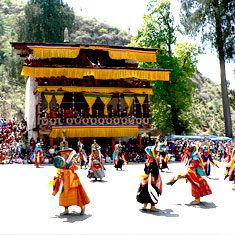
Gomkora Festival | 14th - 16th March 2019
The festival is one of the most popular gathering in eastern Bhutan and attracts visitors from Arunachal Pradesh in India, who walk for days to reach there.
The main highlight of the festival is to ‘circumambulate’ a holy black rock therefore Kora i.e. ‘circumambulation’ is a derivative and a tribute to Guru Rinpoche who subdued a demon at this site in the eighth century. Legend has it that the demon escaped from Tibet and fled to the site and hid inside a big rock that stands today where the festival takes place.
Guru Rinpoche meditated at the cave inside the rock for three days. The demon took the form of a big snake and Guru Rinpoche subdued him in the form of a garuda (a giant mystical bird). The demon was then converted into the guardian deity of the place.
The legacy stands to testify itself at the site where the fight between the garuda and the snake is imprinted on the rock. There is also Guru’s thumbprint indicating the subjugation. Such legends thrive all over the country. This festival also offers an oversight of a unique tradition of eastern Bhutan. The east has many couples who meet during the festival.
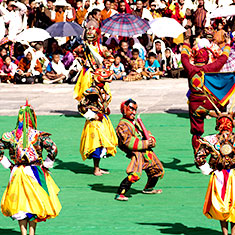
Thimphu Festival | 7th - 9th October 2019
The whole capital comes to life during the festival as public holiday is declared for the four-day event.It began in 1687, which takes place at the courtyard of the offices of the fourth and fifth Kings of Bhutan. People of all ages are seen in their best attire. It is the time when Thimphu has the maximum number of tourists. The crowd runs into thousands and people go to watch the dances very early in the morning.
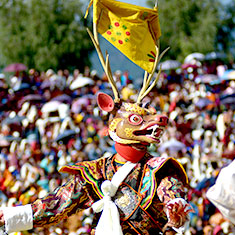
Gangtey Tshechu (festival) | 5th - 7th October 2019
Wangdue is about two hours drive from the capital, Thimphu. The festival is not as crowded as in Thimphu or Paro and offers tourists a good opportunity to experience a tsechu.
It is held at the courtyard of the Wangdue dzong which was built in 1638 and is one of the oldest fortresses in Bhutan. The tsechu has been held at the fortress since the dzong was built.
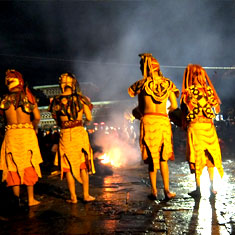
Trashigang Tsechu (festival) | 5th - 7th Dec 2019
Trashigang is one of the biggest towns in eastern Bhutan. During the festival, people all over Trashigang, which includes tribal from Merak and Sakteng, visit and tsechu and it is a good time to see the less known people of Bhutan.
The festival also brings people from all over eastern Bhutan together and it is a good time to experience Bhutan in a way which will be missed by visiting just the capital, Thimphu.
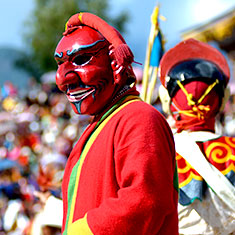
Trongsa Festival | 4th - 7th January 2019
Trongsa, in central Bhutan, is a small town. It was from this place that the royal family came to prominence. The Trongsa dzong is the longest dzong in Bhutan.
The festival is not as crowded as in the western towns and provides more space for tourists to mingle around, take photographs and experience Bhutan.
The Trongsa dzong, built in the 17th century,has a unique collection of historical artifacts as it was the seat of the father of the first king of Bhutan. It also houses a recently converted museum.
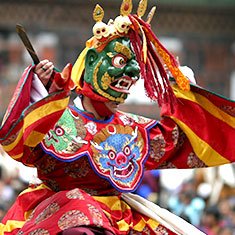
Jambey Lhakhang Drup | 13th - 16th Nov 2019
The festival is held at the Jambey Lhakhang in Bumthang, which was built in the 7th century and is one of the oldest temples in the country. Masked dances and bonfires commemorate the establishment of this 7th century Lhakhang. The highlight of the festival is the fire ritual that is held by midnight where crowds gather to witness the ritual. A naked dance is also performed where the dancers only have their masks on.
The festival is held at Jambey Lhakhang (monastery) in Bumthang, central Bhutan. The hilly town of Bumthang is one of the most scenic places in Bhutan. A distinct feature of this festival is a naked dance performed during the night. It is believed to ward off evil.
The Jambey monastery has mystical roots. It is believed to be one of the 108 monasteries constructed in a single day by a Tibetan King to subdue a demon. Of the two temples built in Bhutan, the other one stands in Paro, called the Kichu temple. The rest of the 106 sister temples are spread all over Tibet.





